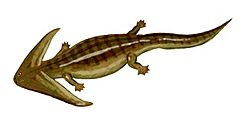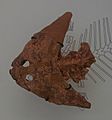Diplocaulus facts for kids
Quick facts for kids DiplocaulusTemporal range: Early to Late Permian
|
|
|---|---|
 |
|
| Diplocaulus magnicornus | |
| Scientific classification | |
| Kingdom: | |
| Phylum: | |
| Class: | |
| Subclass: | |
| Order: |
†Nectridea
|
| Family: |
†Keraterpetontidae
|
| Genus: |
†Diplocaulus
|
| Species | |
|
|
Diplocaulus (say "Dip-loh-KAW-lus") means "double stalk." It was an early amphibian that is now extinct. This amazing creature was not a dinosaur. It lived a very long time ago, during the Permian period. Diplocaulus was special because of its unique boomerang-shaped head. This shape came from two long bones at the back of its head. It had four short legs and a short, flat tail. Diplocaulus grew to be about 3 feet (1 meter) long.
Contents
What Was Diplocaulus?
Diplocaulus was a type of amphibian, like modern frogs and salamanders. But it lived millions of years ago. It belonged to a group called Nectridea. These amphibians often had unusual body shapes. Diplocaulus lived in freshwater environments, such as rivers and swamps. Scientists believe it spent most of its life in the water.
When Did Diplocaulus Live?
Diplocaulus lived during the Permian period. This was a time in Earth's history from about 299 to 252 million years ago. Diplocaulus appeared in the early Permian and became extinct by the late Permian. This means it lived long before the first dinosaurs walked the Earth.
Where Did Diplocaulus Live?
Fossils of Diplocaulus have been found mainly in North America. Most discoveries have been in what is now the United States. This tells us that these ancient amphibians lived in the swamps and rivers of that region.
What Did Diplocaulus Look Like?
The most striking feature of Diplocaulus was its head. It looked like a wide, flat boomerang or an airplane wing. This shape was formed by two long, bony projections. These projections came from the back of its skull.
Why Did Diplocaulus Have a Boomerang Head?
Scientists have different ideas about why Diplocaulus had such a strange head.
- Swimming Aid: One idea is that the wide head helped it swim. It might have acted like a hydrofoil, helping it glide through the water. It could have also helped it stay stable in currents.
- Defense: Another idea is that the head made it harder for predators to swallow. A wide, flat head would be very difficult for a larger animal to fit into its mouth.
- Camouflage: Some scientists think the head helped it blend in. It might have hidden on the bottom of rivers, looking like a leaf or debris.
- Mating Display: It's also possible the head was used to attract mates. Animals often have special features for showing off during mating season.
What Did Diplocaulus Eat?
Diplocaulus was likely a predator. It probably ate small fish and other tiny water creatures. Its flattened body and head suggest it might have waited on the bottom of rivers. Then it would ambush its prey as it swam by.
How Do We Know About Diplocaulus?
We know about Diplocaulus from its fossils. Scientists have found many fossilized skeletons and skulls. These fossils help us understand what it looked like and how it lived.
Who Discovered Diplocaulus?
The first Diplocaulus fossils were found in the late 1800s. The famous paleontologist Edward Drinker Cope described Diplocaulus in 1877. He was one of the first scientists to study these ancient creatures.
Gallery
Images for kids
-
A partial skeleton of Diplocaulus magnicornis skull at the University of Michigan Museum of Natural History
-
A Diplocaulus magnicornis skull at the American Museum of Natural History
See also
 In Spanish: Diplocaulus para niños
In Spanish: Diplocaulus para niños













